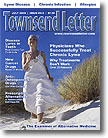


From the Townsend Letter |
||
Anti-Aging Medicine |
||
|
MRSA, or methicillin-resistant Staphylococcus aureus, is a bacterium that belongs to the large group of bacteria known as Staphylococci, often referred to as staph. Interestingly, while an estimated 25% to 30% of people have staph within the nose, it normally does not cause an infection. While only 1% of the population has MRSA, it can be responsible for serious infections, because the bacterium is resistant to numerous antibiotics, including methicillin and penicillin. 1. Know the signs of MRSA and get it treated early. HoneyUsed as a skin treatment, honey prevents infection and speeds healing by starving existing bacteria and protecting the skin from infection by new bacteria. Researchers have shown that the high sugar content of honey actually slows bacterial growth, while its thick, syrupy texture acts as a seal over wounds, forming a natural barrier against any potential bacterial invaders. Furthermore, in its undiluted form, contains intense concentrations of substances that can kill many types of antibiotic-resistant bacteria. A team of researchers from Belfast City Hospital (Ireland) found that three types of honey produced from bees in Northern Ireland and one commercial French honey eradicated a culture of CA-MRSA to none detectable within 24 hours of co-culturing with all four types. Interestingly, inoculated honey remained positive for CA-MRSA until 72 hours postinoculation, after which point no culturable organisms could be detected. Concludes the team: "This study demonstrated that, in vitro, these natural products had an antimicrobial activity against the CA-MRSA organisms." A group from Oslo University Hospital (Norway) incubated various strains of bacteria, including MRSA, and then applied honey to the bacteria growths. Norwegian Forest Honey was found to be bactericidal against all the strains of bacteria. The researchers urge: "Reintroduction of honey as a conventional wound treatment may help improve individual wound care, prevent invasive infections, eliminate colonization, interrupt outbreaks and thereby preserve current antibiotic stocks." GarlicA group from the University of East London (UK) studied the effect of allicin, the main antibacterial agent isolated from garlic, on 30 clinical isolates of MRSA, including strains of CA-MRSA. Allicin was able to inhibit all MRSA strains, and the garlic compound demonstrated bactericidal properties. Using a laboratory model mimicking the MRSA infection, researchers from the Chung Shan Medical University Hospital (Taiwan) found that sulfur compounds present in garlic significantly decreased MRSA viability in the kidney, and decreased both interleukin (IL)-6 and tumor necrosis factor (TNF)-alpha – markers of inflammation. The team states: "These data suggest that [sulfur compounds in garlic] could provide multiple protective functions against MRSA infection." Conclusion Find out how you can uncover the secrets of a healthy, vital, productive lifespan by using the physician directory online at Worldhealth.net, the official educational website of the American Academy of Anti-Aging Medicine (A4M). Log on today to www.worldhealth.net, the leading Internet portal sharing the very latest knowledge in aging intervention as embraced by the A4M's 22,000-plus physician, scientist, and health practitioner members from 105 nations worldwide. While at Worldhealth.net, be sure to sign up for the free Anti-Aging News Journal, delivered weekly to your computer desktop.
|
||
![]()
Consult your doctor before using any of the treatments found within this site.
![]()
Subscriptions are available for Townsend Letter, the Examiner of Alternative Medicine magazine, which is published 10 times each year.
Search our pre-2001
archives for further information. Older issues of the printed magazine
are also indexed for your convenience.
1983-2001
indices ; recent indices
Once you find the magazines you'd like to order, please use our convenient form, e-mail subscriptions@townsendletter.com, or call 360.385.6021 (PST).
Who are we? | New
articles | Featured topics |
Tables of contents | Subscriptions | Contact
us | Links | Classifieds | Advertise | Alternative
Medicine Conference Calendar | Search site | Archives |
EDTA
Chelation Therapy | Home
© 1983-2009 Townsend Letter for Doctors
& Patients
All rights reserved.
Website by Sandy Hershelman
Designs
May 22, 2010
![]()

